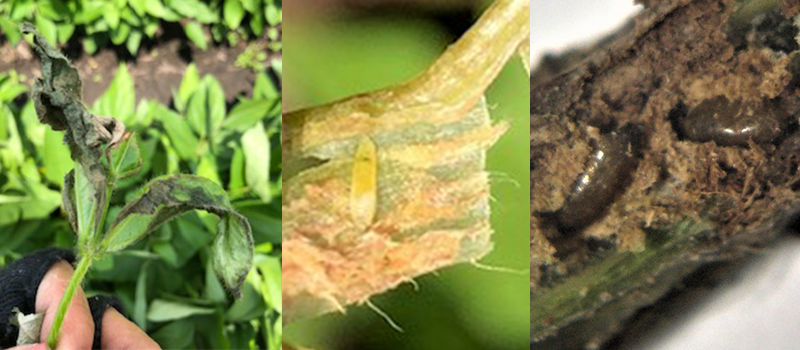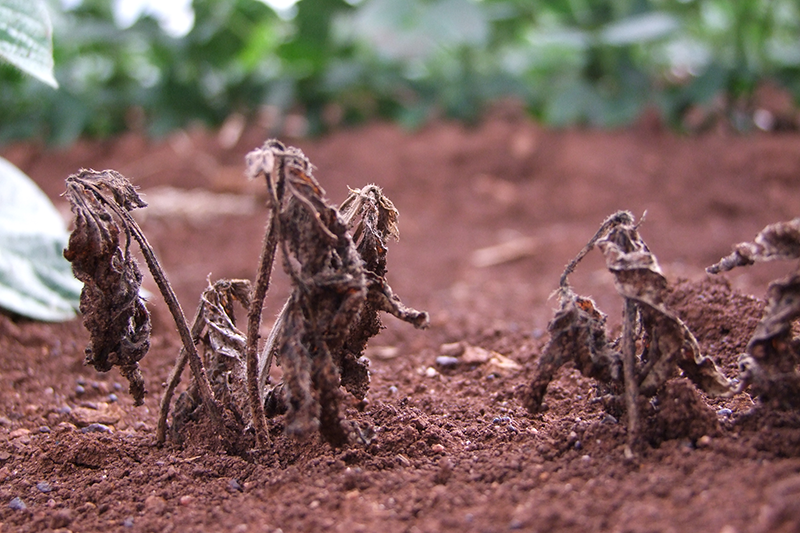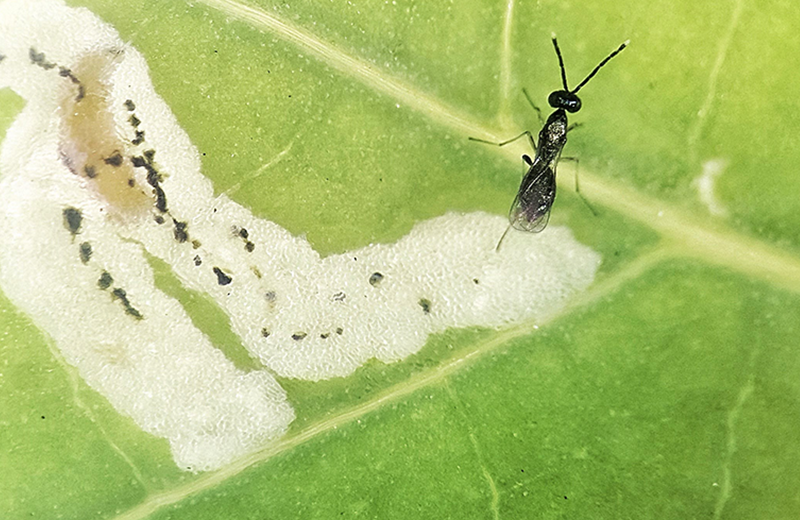Late damage has been reported recently in an Onyx-AU (PBR*) black gram crop in the Burdekin. The most obvious damage was dead leaves, but closer inspection found full sized larvae (3 mm) and pupae in the petioles of damaged leaves. The causal agent was common bean fly Ophiomyia phaseoli (Agromyzidae), but in this instance control was not warranted, as the crop was very close to desiccation and only a low proportion (<5%) of leaves were damaged.

Leaf damage, larva and pupa. Photos by Alejandra Rodriguez and Hugh Brier.
Common bean fly
Bean fly is a pest of several summer pulses (including mungbean, navy beans, and black gram, but not soybean), particularly in coastal regions. Phasey bean (Macroptillum lathyroides) is a common weed host in agricultural areas, and other legume weeds may also be potential hosts.
Bean fly is usually a pest of seeding crops, but infestations can also occur in later crop stages. Female flies lay their eggs into leaves, and the young maggots (larvae) tunnel though leaf tissue, making their way into the midrib and petiole, and eventually into the stem where they pupate. This tunnelling in the plant’s vascular tissue is responsible for plant damage leading to leaf and even plant death.

Damage to vascular tissue by larval tunnelling can result in death of leaves or even whole plants. Photo by Hugh Brier.
Recently introduced species
There are several other exotic species of pest flies of the genus Liriomyza (which are in the same family as common bean fly, but usually slightly smaller) reported as present in Australia that growers and agronomists should be aware of:
The vegetable leafminer (L. sativae) and the American serpentine or celery leafminer (L. trifolii) have been reported on Cape York Peninsula, while the serpentine or pea leafminer (L. huidobrensis) has been reported in the Lockyer Valley, Darling Downs, and Granite Belt. Adult flies of Liriomyza sp. are mostly black on top but have a small yellow segment at the base of their wings. They are yellow underneath, while the bean fly is black all over. Bean flies are normally coastal pests, but we do not know how widespread the exotic leaf-mining flies will become.

CAPTION: Adults of common bean fly, serpentine leafminer, and vegetable leafminer. Photos by Hugh Brier and John Duff (DAF), and the University of Florida
Management options
Bean fly infestations have a greater impact on seedlings, as bigger plants are more tolerant to damage. Thresholds during the seedling stage for bean fly (extrapolated from navy bean thresholds) are 1 larval tunnel per plant. In the later vegetative and pod-filling stages, thresholds for bean fly and leaf-miner flies are based on percentage of leaf death, with 33% being tolerable (with no yield loss) during the mid to late vegetative stages, reducing to 20% during the pod-fill stage.
Dimethoate is registered against bean fly and can be used against the exotic leaf miners under APVMA minor use permit PER89184 (expires 31 March 2025). Heavily infested seedling crops may need a respray; note that label restrictions prevent a second application within 14 days.
The high rate of 800 mL/ha is unfortunately very ‘hard’ on natural enemies, including parasitoid wasps that supress bean fly. Under trial conditions, DAF has achieved bean fly control with dimethoate at much lower rates (250 mL/ha), which are softer on natural enemy populations.

A black parasitoid wasp visits a leaf-mining larva. Photo by John Duff.
Take-home messages
- In seedlings, look for any early plant deaths and check the base of stems for larval tunnelling.
- In more advanced crops, look for dying leaves and check the petioles for bean fly larvae and pupae.
- For the new leaf miners, look for any serpentine leaf mining, as opposed to the whole of leaf deaths due to bean fly.
- Please report any suspicious leaf mines, as well as severe bean fly outbreaks.
For more information, contact Hugh Brier or Trevor Volp (see DAF contacts page).
Acknowledgement: Alejandra Rodriguez, E. E Muir and Sons – Ayr for reporting the Burdekin outbreak.
* Onyx-AU is protected under Plant Breeder’s Rights (PBR) legislation.
